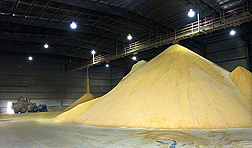Fillers such as clay, talc, glass, paper and metals are commonly used in plastics to increase strength, and also to save costs by reducing the amount of actual plastic resin used. Using bio-based fillers such as bamboo, kenaf, corn stover, soybean hulls or even chicken feathers is receiving increased attention as a way to use less petroleum in plastic products.
 A coproduct of ethanol production could be used as a non-petroleum-based filler in plastics, based on preliminary studies by Agricultural Research Service (ARS) scientists and their cooperators. The ethanol coproduct, called distiller’s dried grains with solubles (DDGS), has a high fiber content and a molecular structure suitable for binding—two attributes that make it a candidate as a filler in plastics, according to ARS agricultural engineer Kurt Rosentrater.
A coproduct of ethanol production could be used as a non-petroleum-based filler in plastics, based on preliminary studies by Agricultural Research Service (ARS) scientists and their cooperators. The ethanol coproduct, called distiller’s dried grains with solubles (DDGS), has a high fiber content and a molecular structure suitable for binding—two attributes that make it a candidate as a filler in plastics, according to ARS agricultural engineer Kurt Rosentrater.
Rosentrater is based at the ARS North Central Agricultural Research Laboratory in Brookings, S.D. He conducted the research with Robert A. Tatara, a professor at the Northern Illinois University (NIU) Department of Technology, part of NIU’S College of Engineering and Engineering Technology.
The researchers compressed molded blends of DDGS and phenolic plastic resin (ranging from 0 to 90 percent DDGS) and found that DDGS concentrations between 25 and 50 percent worked best as fillers in plastics. These findings were published recently in the Journal of Polymers and the Environment (JPE).
The preliminary study yielded only limited data on the resulting physical properties of the various DDGS/plastic blends, so follow-up tests are currently under way. The data can then be used to develop new bio-based manufactured products. Rosentrater and Andrew W. Otieno, also with Northern Illinois University’s Department of Technology, have developed comprehensive guidelines that take into account the unique challenges encountered when manufacturing plastic composites that contain biological materials. This work has also been published in the JPE.
Fillers such as clay, talc, glass, paper and metals are commonly used in plastics to increase strength, and also to save costs by reducing the amount of actual plastic resin used. Using bio-based fillers such as bamboo, kenaf, corn stover, soybean hulls or even chicken feathers is receiving increased attention as a way to use less petroleum in plastic products. Thus both DDGS and distiller’s dried grains (DDG) are candidates for use as biofillers for plastics.
Source
Biobasednews.com, 2008-06-23.
Supplier
ARS National Center for Agricultural Utilization Research
Journal of Polymers and Environment
Northern Illinois University (NIU), Department of Technology
US Department of Agriculture (USDA)
Share
Renewable Carbon News – Daily Newsletter
Subscribe to our daily email newsletter – the world's leading newsletter on renewable materials and chemicals









